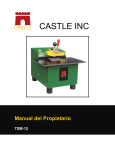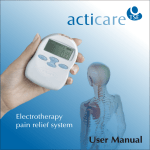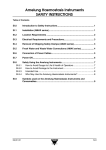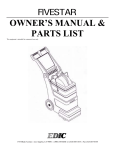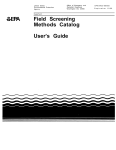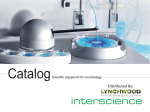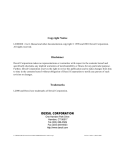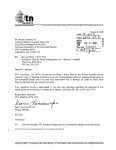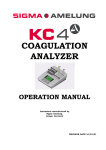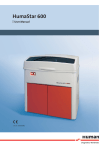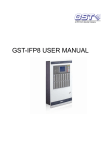Download RaPID Assay PCB Test Kit
Transcript
STRATEGIC DIAGNOSTICS INC. RaPID Assay PCB Test Kit A00133/A00134 Intended Use The RaPID Assay PCB Test Kit can be used as a quantitative, semi-quantitative or qualitative enzyme immunoassay (EIA) for the analysis of PCB (polychlorinated biphenyl) in water (groundwater, surface water, well water). For applications in other matrices please contact our Technical Service department or refer to the soil application procedure provided. The RaPID Assay PCB Test Kit allows reliable and rapid screening for PCB (measured and reported as Aroclor 1254), with quantitation between 0.5 and 10 ppb (as Aroclor 1254), in water. The minimum detection level of the kit is 0.2 ppb (as Aroclor 1254.) Test Principles The PCB RaPID Assay kit applies the principles of enzyme linked immunosorbent assay (ELISA) to the determination of PCB and related compounds. The sample to be tested is added, along with an enzyme conjugate, to a disposable test tube, followed by paramagnetic particles with antibodies specific to PCB attached. Both PCB (which may be in the sample) and the enzyme labeled PCB (the enzyme conjugate) compete for antibody binding sites on the magnetic particles. At the end of an incubation period, a magnetic field is applied to hold the paramagnetic particles (with PCB and labeled PCB analog bound to the antibodies on the particles, in proportion to their original concentration) in the tube and allow the unbound reagents to be decanted. After decanting, the particles are washed with Washing Solution. The presence of PCB is detected by adding the enzyme substrate (hydrogen peroxide) and the chromogen (3,3’,5,5’ – tetramethylbenzidine). The enzyme labeled PCB analog bound to the PCB antibody catalyzes the conversion of the substrate/chromogen mixture to a colored product. After an incubation period, the reaction is stopped and stabilized by the addition of acid. Since the labeled PCB (conjugate) was in competition with the unlabeled PCB (sample) for the antibody sites, the color developed is inversely proportional to the concentration of PCB in the sample. NOTE: Color development is inversely proportional to the PCB concentration. Darker color = lower concentration Lighter color = higher concentration The determination of the PCB level in an unknown sample is interpreted relative to the standard curve generated from kit standards after reading with a spectrophotometer. Performance Characteristics The PCB RaPID Assay will detect different PCB Aroclors to different degrees. Refer to the table below for data on several of these. The PCB RaPID Assay kit provides screening results. As with any analytical technique (GC, HPLC, etc. ) positive results requiring some action should be confirmed by an alternative method. The PCB RaPID Assay immunoassay test does not differentiate between PCB and other related compounds. The table below shows compounds at the method detection limit (MDL) which is the lowest concentration of the compound, in water, that can be picked up in the assay. The limit of quantitation (LOQ) is an approximate concentration, in water, required to yield a positive result at the lowest standard. This is the lowest concentration of the compound that can be quantified in the assay. The IC50 is the concentration required to, inhibit one half of the color produced by the negative control. It is also used to calculate cross-reactivity values to similar compounds. Compound Aroclor 1254 Aroclor 1260 Aroclor 1248 Aroclor 1242 Aroclor 1262 Aroclor 1232 MDL (ppb) 0.20 0.20 0.22 0.34 0.36 0.84 LOQ (ppb) 0.50 0.32 0.59 1.22 0.66 2.61 IC50 (ppb) 3.6 2.3 4.22 8.8 4.74 18.76 2 RaPID Assay PCB Test Kit Aroclor 1268 Aroclor 1016 Aroclor 1221 0.92 0.94 13.54 3.03 3.56 22.58 21.80 25.60 162.60 *The following compounds demonstrated no reactivity in the PCB RaPID Assay test kit at concentrations up to 10,000 ppb: Biphenyl, 2,5-Dichlorophenol, 2,3,5Trichlorophenol, Di-n-octyl-phthalate. The presence of the following substances up to 250 ppm were found to have no significant effect on PCB RaPID Assay results: copper, nickel, zinc, mercury, manganese, phosphate, sulfate, sulfite, magnesium, calcium, nitrate and thiosulfate. Humic acid up to 25 ppm and iron to 100 ppm were found to have no significant effect. In addition, sodium chloride concentrations up to 1.0 M showed no effect on results. Precautions • Training is strongly recommended prior to using the RaPID Assay test system. Contact Strategic Diagnostics for additional information. • Treat PCB, solutions that contain PCB, and potentially contaminated samples as hazardous materials. • Use gloves, proper protective clothing, and methods to contain and handle hazardous material where appropriate. • • • • Reagents must be added in a consistent manner to the entire rack. A consistent technique is the key to optimal performance. Be sure to treat each tube in an identical manner. Water samples should be at a neutral pH prior to analysis. Samples containing gross particulate should be filtered (e.g. 0.2 um AnotopTM 25 Plus, Whatman, Inc.) to remove particles. Store all test kit components at 2°C to 8°C (36°F to 46°F). Storage at ambient temperature (18°C to 27°C or 64°F to 81°F) on the day of use is acceptable. Test tubes require no special storage and may be stored separately to conserve refrigerator space. Allow all reagents to reach ambient temperature (18°C to 27°C or 64°F to 81°F) before beginning the test. This typically requires at least 1 hour to warm from recommended storage conditions. • Do not freeze test kit components or expose them to temperatures above 100°F (39°C). • Do not use test kit components after the expiration date. • Do not use reagents or test tubes from one test kit with reagents or test tubes from a different test kit. • Do not mix reagents from kits of different lot numbers. • Use approved methodologies to confirm any positive results. • Do not under any circumstances attempt to disassemble the base of the magnetic rack. Magnets will be violently attracted to each other. • Adequate sample number and distribution are the responsibility of the analyst. • The photometer provided in the accessory kit requires electricity and comes with a 110V adapter. Adapters for 220V are available. Do not attempt to operate with a car adaptor. • Do not expose color solution to direct sunlight. • Do not dilute or adulterate test reagents or use samples not called for in the test procedure; this may give inaccurate results. • Tightly recap the standard vials when not in use to prevent evaporative loss. Materials Provided • Antibody Coupled Paramagnetic Particles in buffered saline containing preservative and stabilizers. 30 test kit: one 20 mL vial 100 test kit: one 65 mL vial • Enzyme Conjugate. 30 test kit: one 10 mL vial 100 test kit: one 35 mL vial • Standards Three concentrations (0.25, 1.0 and 5.0 ppb) of PCB standards (as Aroclor 1254) in buffered saline RaPID Assay PCB Test Kit containing preservative and stabilizers are supplied. Each vial contains 4 mL. • • 3 • EppendorfTM Repeater® Pipettor • Electronic timer Control • A concentration (approximately 3 ppb) of PCB (as Aroclor 1254) in buffered saline containing preservative and stabilizers. A 4 mL volume is supplied in one vial. Portable balance capable of weighing 10 g (for soil samples) • Vortex mixer • Magnetic separation rack Diluent/Zero Standard • RPA-I RaPID Analyzer (or equivalent spectrophotometer capable of reading 450 nm in a 1 mL sample size). Buffered saline containing preservative and stabilizers without any detectable PCB. 30 test kit: one 10 mL vial 100 test kit: one 35 mL vial • Color Solution containing hydrogen peroxide and 3,3’,5,5’-tetramethylbenzidine in an organic base. 30 test kit: one 20 mL vial 100 test kit: one 65 mL vial • Stop Solution containing a solution of 2M sulfuric acid. 30 test kit: one 20 mL vial 100 test kit: one 60 mL vial • • • • 12.5 mL Combitips® for the Repeater pipettor - for 0.25 mL to 1.25 mL dispensing volumes (5) • Pipet tips for adjustable volume pipet (100-1000 uL) NOTE: Order replacement Combitips® and pipet tips separately. See the “Ordering Information" section. Materials Required but Not Provided • Methanol (HPLC grade or equivalent) – for water analysis • Protective clothing (e.g., latex gloves) 30 test kit: one 70 mL vial 100 test kit: one 250 mL vial • Absorbent paper for blotting test tubes • Liquid and solid waste containers Polystyrene test tubes • Marking pen 30 test kit: one 36 tube box 100 test kit: three 36 tube boxes • Instructional video (optional) Washing Solution containing preserved deionized water. User’s Guide Materials Required and Ordered Separately See “Ordering Information” for the appropriate catalogue numbers. Rapid Assay Accessory Kit Accessory equipment may be rented or purchased from Strategic Diagnostics. See “Ordering Information” for the appropriate catalogue numbers. The accessory kit contains the following items: • Other Items Adjustable Volume Pipet Suggestions for Pipettor Use • Practice using both pipettes (adjustable volume and Repeater pipettor) with water and extra tips before you analyze your samples. • Use a new tip each time you use the Repeater pipettor to pipette a different reagent to avoid reagent crosscontamination. Tips can be rinsed thoroughly, dried completely and reused. By using the same tip to dispense the same reagent each time you can avoid cross contamination. NOTE: Repeator tips should be changed periodically (after ~10 uses) since precision deteriorates with use. 4 RaPID Assay PCB Test Kit • Draw the desired reagent volume into the Repeater pipettor and dispense one portion of the reagent back into the container to properly engage the ratchet mechanism. If you do not do this, the first volume delivered may be inaccurate. • To add reagents using the Repeater pipettor, pipette down the side of the test tube just below the rim. • • When adding samples and standard using the positive displacement pipettor, always pipette into the bottom of the tube without touching the sides or bottom of the tube. Use a new adjustable volume pipet tip each time you pipette a new unknown. Assay Procedure Prior to performing your first Rapid Assay, please take time to read the package inserts in their entirety and review the videotape if available. On site training is strongly recommended for new users of this test system. Please contact your account manager for further information. This procedure is designed for quantitative analysis. For running the kit semi-quantitatively or qualitatively, please contact Technical Support. Collect/Store the Sample The following steps explain how to properly collect and store your samples. 1. Water samples should be collected in glass vessels with teflon cap liners). Immediately upon collection, water samples should be diluted with an equal volume (1:1) of methanol (HPLC grade) to prevent adsorptive losses to the glass containers. This is a 2x dilution, which must be accounted for when interpreting results. See “Results Interpretation”, Section 3a for further details. Use this diluted sample as “sample” in “Perform the Test”. NOTE: This 2x dilution is not required for soil samples. 2. Samples should be collected in appropriately sized and labeled containers. 3. If testing soil samples, follow the SDI Sample Extraction Kit User’s Guide or the appropriate technical bulletin to properly collect and store your sample. 4. Samples should be tested as soon as possible after collection. If this is not possible, storage at 4°C (39°F) is recommended to minimize evaporative losses. Set Up 1. Remove kits from refrigerator. All reagents must be allowed to come to room temperature prior to analysis. Remove reagents from packaging and place at room temperature at least 1 hour prior to testing. 2. Turn on the RPA-1 or other spectrophotometer. The RPA-1 should be warmed up for at least 30 minutes prior to the run. 3. Label five 12.5 mL Combitips “Conjugate”, “Particles”, “Wash”, “Color” and “Stop”. In addition, add the name of the compound you are testing for to each Combitip. 4. Remove nine clean blank test tubes for standards and control and one test tube for each sample (if testing in singlicate). Label the test tubes according to contents as follows. Tube # 1 2 3 4 5 6 7 8 9 10 11 Contents Negative control (replicate 1) Negative control (replicate 2) Standard 1 (replicate 1) Standard 1 (replicate 2) Standard 2 (replicate 1) Standard 2 (replicate 2) Standard 3 (replicate 1) Standard 3 (replicate 2) Control Sample 1 Etc. *Label at top of tubes to avoid interference with reading of tubes in photometer Sample Extraction, Filtration and Dilution Filtration may be necessary to remove gross particulate from the water sample. If testing samples at levels higher than standard kit level is desired, contact SDI for special instructions. Water samples should be diluted 1:1 in methanol as described in “Collect/Store the Sample”. Please follow the instructions from the SDI Sample Extraction Kit to prepare and dilute the soil extract prior to running the assay. RaPID Assay PCB Test Kit Perform the Test 1. Separate the upper rack from the magnetic base. Place labeled test tubes into the rack. 2. Add 200 uL of standards, control or samples to the appropriate tubes using the adjustable volume pipet with the dial set on 0200. The negative control, standards and control must be run with each batch of samples. NOTE: Sample should be added to the bottom of the tube by inserting the pipet tip into the tube without touching the sides or the bottom of the tube. Take care not to contact sample with pipette tip once dispensed into bottom of the tube. 3. Using the Repeater Pipettor with the “Conjugate” tip attached and the dial set on “1”, add 250 uL of Enzyme conjugate down the inside wall of each tube. (Aim the pipet tip ¼” to ½” below the tube rim or tube wall; deliver liquid gently to avoid splashback.) 4. Thoroughly mix the magnetic particles by swirling (avoid vigorous shaking) and attach the “Particles” tip to the Repeater Pipettor. With the dial set on “2” add 500 uL of magnetic particles to each tube, aiming down the side of the tube as described above. Vortex, mixing each tube 1 to 2 seconds at low speed to minimize foaming. Pipetting of magnetic particles should be kept to 2 minutes or less. 5. Incubate 15 minutes at room temperature. 6. After the incubation, combine the upper rack with the magnetic base and press all tubes into the base; allow 2 minutes for the particles to separate. 5 9. Set the Repeater Pipettor dial to “4” and put on the tip labeled “Wash”. Add 1 mL of Washing Solution down the inside wall of each tube by using the technique described earlier. Vortex tubes for 1-2 seconds. Wait 2 minutes and pour out the tube contents as described previously. Repeat this step one more time. NOTE: The number of washes and wash volume are important in ensuring accurate results. 10. Remove the upper rack (with its tubes) from the magnetic base. With the “Color” tip attached to the Repeater Pipet and the dial set to “2” add 500 uL of Color Reagent down the inside wall of each tube as described previously. Vortex 1 to 2 seconds (at low speed). 11. Incubate 20 minutes at room temperature. During this period, add approximately 1 mL of Washing solution to a clean tube for use as an instrument blank for “Results Interpretation”. 12. After the incubation, position the Repeater pipettor at Setting “2” and use the “Stop” tip to add 500 uL of Stop solution to all test tubes. 13. Proceed with results interpretation. WARNING: Stop solution contains 2M sulfuric acid. Handle carefully. Results Interpretation 1. After addition of Stop Solution to the test tubes, results should be read within 15 minutes. 7. With the upper rack and magnetic base combined, use a smooth motion to invert the combined rack assembly over a sink and pour out the tube contents. 2. Wipe the outside of all antibody coated tubes prior to photometric analysis to remove fingerprints and smudges. NOTE: If the rack assembly inadvertently comes apart when lifting to pour out tube contents, recombine and wait an additional 2 minutes to allow particles to separate. Photometric Interpretation Using the RPA-I 8. Keep the rack inverted and gently blot the test tube rims on several layers of paper towels. It is important to remove as much liquid as possible but do not bang the rack or you may dislodge the magnetic particles and affect the results. 1. The RPA-I photometer (provided in the Rapid Assay Accessory kit) can be used to calculate and store calibration curves. It is preprogrammed with various RaPID Assay protocols. For the PCB RaPID Assay test kit, parameter settings are as follows: Data Reduct : Lin. Regression 6 RaPID Assay PCB Test Kit Xformation : Ln/LogitB Read Mode : Absorbance Wavelength : 450 nm Units : PPB # Rgt Blk : 0 : 4 # of Reps : 2 NOTE: Tube order is important. The RPA-I expects to see the standards in ascending order, in duplicate, starting with the negative control. Following evaluation of all standards, the instrument will display: Concentrations: #1 : 0.00 ppb #2 : 0.25 ppb #3 : 1.00 ppb #4 : 5.00 ppb Range : 0.10 – 5.00 Correlation : 0.990 Rep. %CV : 10% NOTE: Prior to analysis the RPA-I User’s Manual should be thoroughly reviewed for more detailed operation instructions. 2. Follow the instrument prompts to read the absorbance of all tubes: Instrument Display Operator Response SELECT COMMAND RUN PROTOCOL Press RUN Scroll using the YES [] or NO [] keys until the desired protocol appears. Then press ENTER Press 1 (for analysis of samples in singlicate.) Press ENTER Insert blank tube containing 1mL wash solution. Remove tube SPL. REPLICATES (1-5) BLANK TUBE, INSERT TUBE, EVALUATING TUBE, REMOVE TUBE (Beep) CAL #1, REP. #1, INSERT TUBE, Remove tube Follow prompts to read tubes. Calibrators: # of Cals EVALUATING TUBE, REMOVE TUBE (Beep) Insert Tube #1 PRINTING DATA, Data will print PRINTING CURVE Curve will print only if programmed to print (See RPA1 User’s Manual). CTRL #1 REP #1, INSERT TUBE, EVALUATING TUBE, REMOVE TUBE (Beep) Insert Control Tube EDIT CALIBRATORS YES/NO Press NO (if editing is necessary press YES and refer to the RPA1 User’s Manual). SPL #1 REP#1 INSERT TUBE EVALUATING TUBE REMOVE TUBE (Beep) Insert first sample tube Remove Tube Remove tube Continue to follow prompts. After all samples have been read, press STOP. Expected Results: • %CV (coefficient of variation) between standard duplicates of 10% or less. • Absorbance reading for the 0 ppb standard should be between 0.8 and 2.0 for all assays. • Correlation (r) of 0.990 or greater for all assays. • Kit control within range specified on vial. • Absorbance of negative control and standards should be as follows: Negative Control>Std. 1>Std. 2>Std. 3. RaPID Assay PCB Test Kit 3. Concentrations will be indicated for all samples on the RPA-I printout. a) The concentration, as indicated on the printout, is multiplied by the appropriate dilution factor (if applicable) introduced in the procedure. The quantitation range of the kit is also multiplied by this factor. EXAMPLE: Water samples were diluted 2-fold with methanol upon collection (see “Collect/Store the Sample” in this User’s Guide). As a result, the concentrations listed on the printout should be multiplied by 2 to determine the sample concentration. The standard concentrations are also multiplied by 2 to give a quantitation range in water for this test kit of 0.5 to 10 ppb. b) Samples with an “nd” and no concentration listed have an absorbance greater than the negative control; therefore, no concentration can be computed for these samples. Results must be reported as < 0.5 ppb (or Standard 1 multiplied by the dilution factor.) c) Samples with an “nd” next to a listed concentration have an estimated concentration below the minimum detection level of the test kit. Results must be reported as <0.5 ppb (or Standard 1 multiplied by the dilution factor.) NOTE: Any samples with concentrations determined to be lower than Standard 1 (the limit of quantitation) must be reported as < 0.5 (or Standard 1 multiplied by the dilution factor.) Quantitation is not possible below this standard as this is outside the linear range of the assay. d) Similarly, samples with a “hi” next to a listed concentration have an estimated concentration higher than Standard 3 and must be reported as >10 ppb (or Standard 3 multiplied by the dilution factor.) NOTE: In order to determine the concentration of samples with concentrations greater than Standard 3, they must be subjected to repeat testing using a diluted sample. A ten-fold or greater dilution of the sample is recommended with an appropriate amount of PCB diluent. This additional dilution must then be 7 taken into account when calculating the concentration. Please contact technical support for assistance in performing dilutions. Photometric Interpretation Using Other Photometers Other photometers may also be used to interpret results obtained from the RPA-I photometer. It is important that the photometer be able to read absorbance at 450nm and that the instrument can read at a 1 mL fill volume. Absorbances obtained from other spectrophotometers (reading at 450 nm) may be used to manually calculate sample concentrations as outlined below. 1. Calculate the mean absorbance for each of the three standards and the negative control. 2. Determine the standard deviation and %CV (coefficient of variation) of each standard and ensure %CV is less than 10% for each. 3. Calculate the %B/Bo for each standard by dividing the mean absorbance value for the standard by the mean absorbance value for the negative control and multiplying the results by 100. 4. Construct a standard curve by plotting the %B/Bo for each standard on the vertical logit (y) axis versus the corresponding analyte concentration on the horizontal logarithmic (x) axis on the graph paper provided in the test kit. Graph papers are specific for each method. Use only the graph paper supplied with each kit. 5. Draw the best straight line through all points. Using the %B/Bo of the sample, the concentration can be interpolated from the standard curve. 6. Multiply results by the appropriate dilution factor (if applicable) introduced in the procedure. For example, if the sample was diluted 10-fold to increase the detection levels of the kit then the results must be multiplied by 10. This dilution also changes the range of the assay (standards) by the same factor. NOTE: Do not forget to account for the 2x dilution introduced in the “Collect/Store the Sample” procedure for water samples. 8 Limitations of the Procedure RaPID Assay PCB Test Kit The Rapid Assay PCB Test Kit is a screening test only. Sampling error may significantly affect testing reliability. Adequate sample number and distribution are the responsibility of the analyst. RaPID Assay PCB Test Kit 9 Ordering Information Description Catalogue Number A00133/A00134 Rapid Assay PCB Kit 6050100 Rapid Assay Accessory Kit** Adjustable Volume Pipet Tips (100-1000 uL) A00013 12.5 mL Combitip for Repeating Pipette (1 each) A00009 PCB Diluent A00136 PCB Soil Proficiency Sample A00175 6997010 Rapid Assay Accessory Kit Rental ** To obtain part numbers and pricing for individual items in the Accessory Kit contact SDI at the number below. Ordering/Technical Assistance Should you have any questions regarding this procedure prior to analysis contact Technical Service to avoid costly mistakes. To Place an Order or Receive Technical Assistance, please call Strategic Diagnostics Inc. at: Call toll-free 800-544-8881` Or 302-456-6789 Phone 302-456-6782 Fax Web site: www.sdix.com E-mail: [email protected] General Limited Warranty SDI’s products are manufactured under strict quality control guidelines and are warranted to be free from defects in materials and workmanship. New instruments and related non-expendable items are warranted for one year from date of shipment against defective materials or workmanship under normal use and service. Warranty obligation is limited to repair or replacement of the defective product or to refund of the purchase price, at the discretion of SDI. Other warranties, express or implied, are disclaimed. SDI’s liability under any warranty claim shall not exceed the refund of the purchase price paid by the customer. Under no circumstances shall SDI be liable for special, indirect or consequential damages. Safety To receive an MSDS for this product, visit our web site at www.sdix.com. Copyright© 1997, Strategic Diagnostics Inc., Z00245.1, Rev 4/4/00 Operation of the Repeater Pipet Operation of the Adjustable Volume Pipet To Set or Adjust Volume To Set or Adjust Volume To determine the pipetting volume, the dial setting (1-5) is multiplied by the minimum pipetting volume of the tip (indicated on the side of the Combitip, e.g. 1~100 uL.) Press release button on side of pipette and turn the push-button to adjust volume up or down. Volume setting is displayed on top of pipet. See kit instructions for appropriate setting. Pipet will accurately dispense volumes between 100 and 1000 uL. To Assemble Pipet Tip Slide filling lever down until it stops. Then raise the locking clamp and insert the tip until it clicks into position. Be sure the tip plunger is fully inserted into the barrel before lowering the locking clamp to affix the tip in place. To Fill Tip With tip mounted in position on pipet, immerse end of tip into solution. Slide filling lever upward slowly. Combitip will fill with liquid. To Dispense Sample Check the volume selection dial to ensure pipetting volume. Place tip inside test tube so that tip touches the inner wall of tube. Completely depress the pipetting lever to deliver sample. NOTE: Dispense one portion of reagent back into the container to engage the ratchet mechanism and ensure accuracy. To Eject Tip Empty tip of any remaining solution into appropriate container by pushing filling lever down. Raise locking clamp upward, and remove the Combitip. To Assemble Pipet Tip Gently push nose cone of pipet firmly into a pipet tip contained in the pipet tip rack. To Withdraw Sample Keep pipet almost vertical. With tip mounted in position on pipet, press push-button to 1st stop and hold it. Place tip at bottom of liquid sample and slowly release push-button to withdraw measured sample. Ensure that no air bubbles exist in the pipette tip. If bubbles exist, dispense sample and re-withdraw. Slide tip out along the inside of the vessel. To Dispense Sample Wipe any liquid from outside of tip taking care not to touch orifice. Place tip into tube, almost to the bottom, and slowly press push-button to 2nd stop. Hold push-button at 2nd stop when removing tip from tube. To Eject Tip Press push-button to 3rd stop. Tip is ejected. STRATEGIC DIAGNOSTICS INC. RaPID Assay PCB In Soil Application ______________________________________________________________________ Intended Use For detection of Polychlorinated Biphenyls (PCB’s) (as Aroclor 1254) in soil. For testing in other matrices, please contact our technical support department at 1-800-544-8881. Materials Required but Not Provided SDI Sample Extraction Kit (Part Number: A00137EA/A00137EB) Procedural Notes and Precautions • • • Prepare soil samples for analysis according to the procedure in the SDI Sample Extraction Kit Users Guide. After extraction and dilution of samples, follow the immunoassay procedure as described in the Rapid Assay ® PCB Test Kit User’s Guide. The initial 2x dilution described for water samples in Step 1 of “Collect/Store the Sample” does not need to be performed for soil samples. RPA-1 Analyzer as listed below to automatically correct for this dilution factor. 1. The RPA-I photometer (provided in the Rapid Assay Accessory kit) can be used to calculate and store calibration curves. To obtain soil results from the PCB Rapid Assay test kit on the RPA-I the following parameter settings are recommended: Data Reduct : Lin. Regression Xformation : Ln/LogitB Read Mode : Absorbance Wavelength : 450 nm Units : PPM # Rgt Blk : 0 # of Cals : 4 # of Reps : 2 Calibrators: Quality Control Concentrations: #1 : 0.00 PPM A control solution at approximately 3 ppb (as Aroclor 1254) is provided with the PCB RaPID Assay Kit. It is recommended that it be included in every run and treated in the same manner as unknown samples. If running standard soil procedures an acceptable result should be 2000 times the value stated on the control vial (i.e. 6.0 + or – 1.2 ppm) when the control results are corrected for the dilution factors (see Results section below). #2 : 0.50 PPM #3 : 2.00 PPM #4 : 10.00 PPM Range : 0.5 – 10.00 Correlation : 0.990 Rep. %CV : 10% Results Interpretation Performance Data Interpret soil sample results as described in the RaPID Assay PCB Test Kit procedure, accounting for the total dilution factor indicated in the table of the SDI Sample Extraction Kit Users Guide. Alternatively, program the The PCB RaPID Assay does not differentiate between PCB and other related compounds. The table below shows compounds at the method detection limit (MDL) which is the lowest concentration of the compound in soil that can be picked up in the assay. The limit of quantitation (LOQ) is an approximate concentration required to yield a positive result at the lowest standard, this is the lowest concentration of the compound in soil that can be quantified in the assay. The IC50 is the concentration in soil required to inhibit one half of the color produced by the negative control. It is also used to calculate cross-reactivity values to similar compounds. Compound Aroclor 1254 Aroclor 1260 Aroclor 1248 Aroclor 1242 Aroclor 1262 Aroclor 1232 Aroclor 1268 Aroclor 1016 Aroclor 1221 MDL (ppm) 0.20 0.20 0.22 0.34 0.36 0.84 0.92 0.94 13.54 LOQ (ppm) 0.5 0.3 0.6 1.2 0.7 2.6 3.0 3.6 22.6 IC50 (ppm) 3.60 2.30 4.22 8.80 4.74 18.76 21.80 25.60 162.6 Soil Contaminants Some contaminants found in soils that also contain PCB’s can interfere with the analysis and cause false positives, false negatives or both when the compound is present at elevated concentrations. Interferences were assessed by adding increasing concentrations of some relevant contaminants to blank and PCB spiked soils prior to the extraction procedure. The concentration of the compound shown below produced no evidence of interference in a positive or negative direction in the 500 ppb to 10 ppm detection range of the procedure described above. soil contaminant concentration in soil producing no interference trichloroethylene gasoline transformer oil 1-chloronapthalene 1,2,4 trichlorobenzene diesel fuel 100,000 ppm or 10% 25,000 ppm or 2.5% 5,000 ppm or 0.5% 2,000 ppm or 0.2% 1,000 ppm or 0.1% 1,000 ppm or 0.1% If additional dilutions of the soil extract are made to detect soil PCB concentrations greater than 10 ppm, these interferences are diminished in direct proportions to the dilution made. Z00254.1 Rev. 4/10/00 Range of Detection The PCB RaPID Assay has a range of detection in soil of 500 ppb to 10 ppm (as Aroclor 1254) when used in conjunction with the SDI Sample Extraction Kit. Recovery PCB recoveries will vary depending on soil type, retention mechanism, solvent and extraction apparatus used, length of extraction period and levels of potentially interfering substances in the soil.













